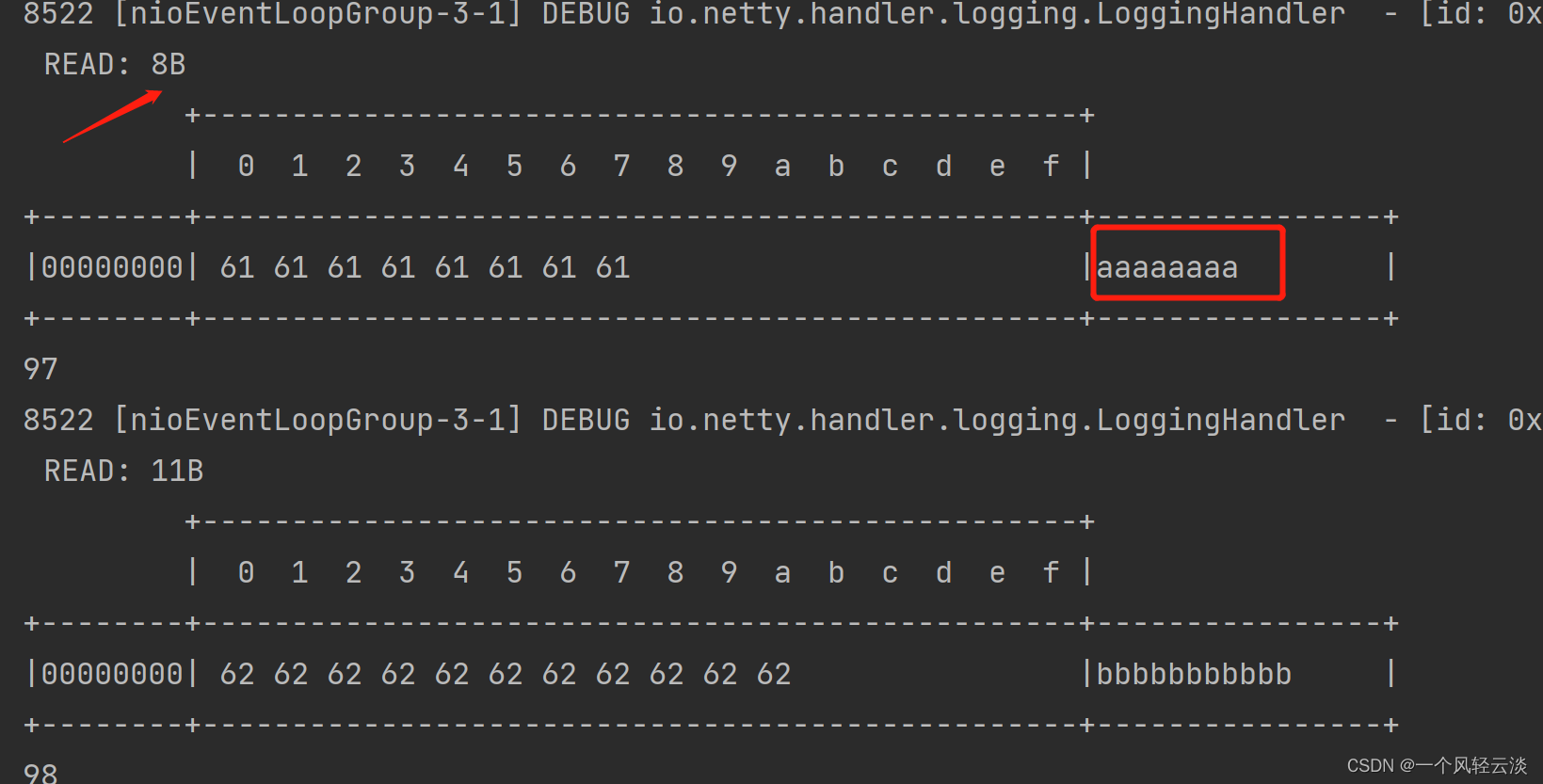粘包和半包的解决
粘包产生
如上服务器端的某次输出,可以看到一次就接收了 160 个字节,而非分 10 次接收
半包产生
客户端代码希望发送 1 个消息,这个消息是 160 字节,代码改为
为现象明显,服务端修改一下接收缓冲区,其它代码不变
服务器端的某次输出,可以看到接收的消息被分为两节,第一次 20 字节,第二次 140 字节
注意
serverBootstrap.option(ChannelOption.SO_RCVBUF, 10) 影响的底层接收缓冲区(即滑动窗口)大小,仅决定了 netty 读取的最小单位,netty 实际每次读取的一般是它的整数倍
现象分析
粘包
- 现象,发送 abc def,接收 abcdef
- 原因
- 应用层:接收方 ByteBuf 设置太大(Netty 默认 1024)
- 滑动窗口:假设发送方 256 bytes 表示一个完整报文,但由于接收方处理不及时且窗口大小足够大,这 256 bytes 字节就会缓冲在接收方的滑动窗口中,当滑动窗口中缓冲了多个报文就会粘包
- Nagle 算法:会造成粘包
半包
- 现象,发送 abcdef,接收 abc def
- 原因
- 应用层:接收方 ByteBuf 小于实际发送数据量
- 滑动窗口:假设接收方的窗口只剩了 128 bytes,发送方的报文大小是 256 bytes,这时放不下了,只能先发送前 128 bytes,等待 ack 后才能发送剩余部分,这就造成了半包
- MSS 限制:当发送的数据超过 MSS 限制后,会将数据切分发送,就会造成半包
本质是因为 TCP 是流式协议,消息无边界
滑动窗口
TCP 以一个段(segment)为单位,每发送一个段就需要进行一次确认应答(ack)处理,但如果这么做,缺点是包的往返时间越长性能就越差
为了解决此问题,引入了窗口概念,窗口大小即决定了无需等待应答而可以继续发送的数据最大值
窗口实际就起到一个缓冲区的作用,同时也能起到流量控制的作用
- 图中深色的部分即要发送的数据,高亮的部分即窗口
- 窗口内的数据才允许被发送,当应答未到达前,窗口必须停止滑动
- 如果 1001~2000 这个段的数据 ack 回来了,窗口就可以向前滑动
- 接收方也会维护一个窗口,只有落在窗口内的数据才能允许接收
MSS 限制
链路层对一次能够发送的最大数据有限制,这个限制称之为 MTU(maximum transmission unit),不同的链路设备的 MTU 值也有所不同,例如
以太网的 MTU 是 1500
FDDI(光纤分布式数据接口)的 MTU 是 4352
本地回环地址的 MTU 是 65535 - 本地测试不走网卡
MSS 是最大段长度(maximum segment size),它是 MTU 刨去 tcp 头和 ip 头后剩余能够作为数据传输的字节数
ipv4 tcp 头占用 20 bytes,ip 头占用 20 bytes,因此以太网 MSS 的值为 1500 - 40 = 1460
TCP 在传递大量数据时,会按照 MSS 大小将数据进行分割发送
MSS 的值在三次握手时通知对方自己 MSS 的值,然后在两者之间选择一个小值作为 MSS
Nagle 算法
- 即使发送一个字节,也需要加入 tcp 头和 ip 头,也就是总字节数会使用 41 bytes,非常不经济。因此为了提高网络利用率,tcp 希望尽可能发送足够大的数据,这就是 Nagle 算法产生的缘由
- 该算法是指发送端即使还有应该发送的数据,但如果这部分数据很少的话,则进行延迟发送
- 如果 SO_SNDBUF 的数据达到 MSS,则需要发送
- 如果 SO_SNDBUF 中含有 FIN(表示需要连接关闭)这时将剩余数据发送,再关闭
- 如果 TCP_NODELAY = true,则需要发送
- 已发送的数据都收到 ack 时,则需要发送
- 上述条件不满足,但发生超时(一般为 200ms)则需要发送
- 除上述情况,延迟发送
解决方案
- 短链接,发一个包建立一次连接,这样连接建立到连接断开之间就是消息的边界,缺点效率太低
- 每一条消息采用固定长度,缺点浪费空间
- 每一条消息采用分隔符,例如 \n,缺点需要转义
- 每一条消息分为 head 和 body,head 中包含 body 的长度
短链接
发完马上关闭,下一次发送再次重新连接
但是对于半包这种是不好解决掉的,因为接收方的缓冲区大小它是有限的
固定长度
让所有数据包长度固定(假设长度为 8 字节),服务器端加入
FixedLengthFrameDecoder
一种解码器,用于按固定的字节数拆分接收到的 ByteBufs。例如,如果您收到以下四个分段数据包:
+---+----+------+----+
| A | BC | DEFG | HI |
+---+----+------+----+
A FixedLengthFrameDecoder(3) 会将它们解码为以下三个具有固定长度的数据包:
+-----+-----+-----+
| ABC | DEF | GHI |
+-----+-----+-----+
修改客户端,客户端代码如下
这里可以看到客户端是一口气发送完的,但在服务端的解析如下:
缺点是,数据包的大小不好把握
- 长度定的太大,浪费
- 长度定的太小,对某些数据包又显得不够
固定分隔符
服务端加入,默认以 \n 或 \r\n 作为分隔符,如果超出指定长度仍未出现分隔符,则抛出异常
LineBasedFrameDecoder
一个解码器,用于在行尾拆分收到的 ByteBuf。
两者和"\n""\r\n"处理。
字节流应采用 UTF-8 字符编码或 ASCII。当前的实现使用直接byte强制char转换,然后将其与一些低范围的 ASCII 字符(如 '\n' or '\r')进行比较char。UTF-8 未对多字节代码点表示形式使用低范围 [0..0x7F] 字节值,因此此实现完全支持。
客户端在每条消息之后,加入 \n 分隔符
客户端发送的数据
服务器端解析的数据
缺点,处理字符数据比较合适,但如果内容本身包含了分隔符(字节数据常常会有此情况),那么就会解析错误
预设长度
在发送消息前,先约定用定长字节表示接下来数据的长度
LengthFieldBasedFrameDecoder
一种解码器,它按消息中长度字段的值动态拆分收到的 ByteBufs。当您解码二进制消息时,它特别有用,该二进制消息具有表示消息正文或整个消息长度的整数标头字段。
经典构造办法:
创建新实例。
参数:
maxFrameLength:最大帧长度 ― 帧的最大长度。如果帧的长度大于此值, TooLongFrameException 将被抛出。
lengthFieldOffset:长度字段偏移量 – 长度字段的偏移量
lengthFieldLength:长度字段长度 – 长度字段的长度
lengthAdjustment:长度调整 – 要添加到长度字段值的补偿值
initialBytesToStrip :剥离字节数 ― 从解码帧中剥离的第一个字节数
调整客户端代码
客户端发送的数据
服务端接收的数据
- 点赞
- 收藏
- 关注作者














评论(0)